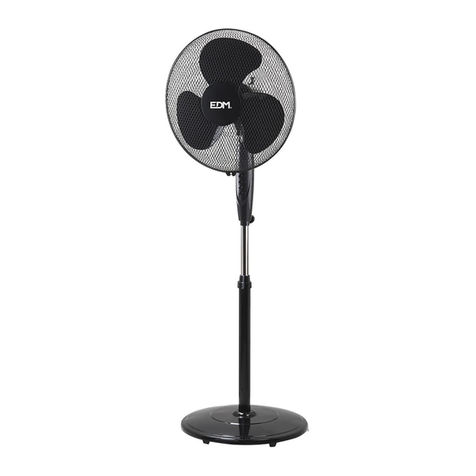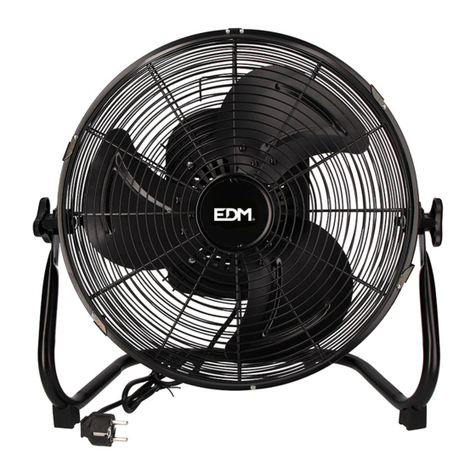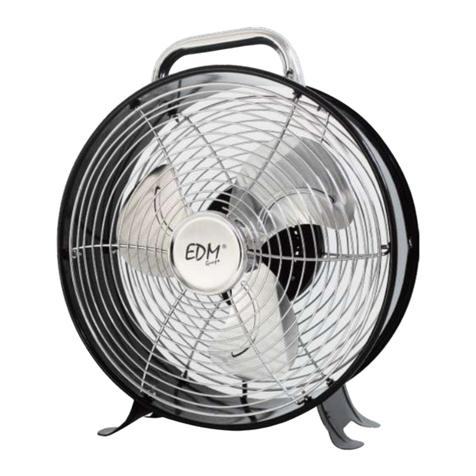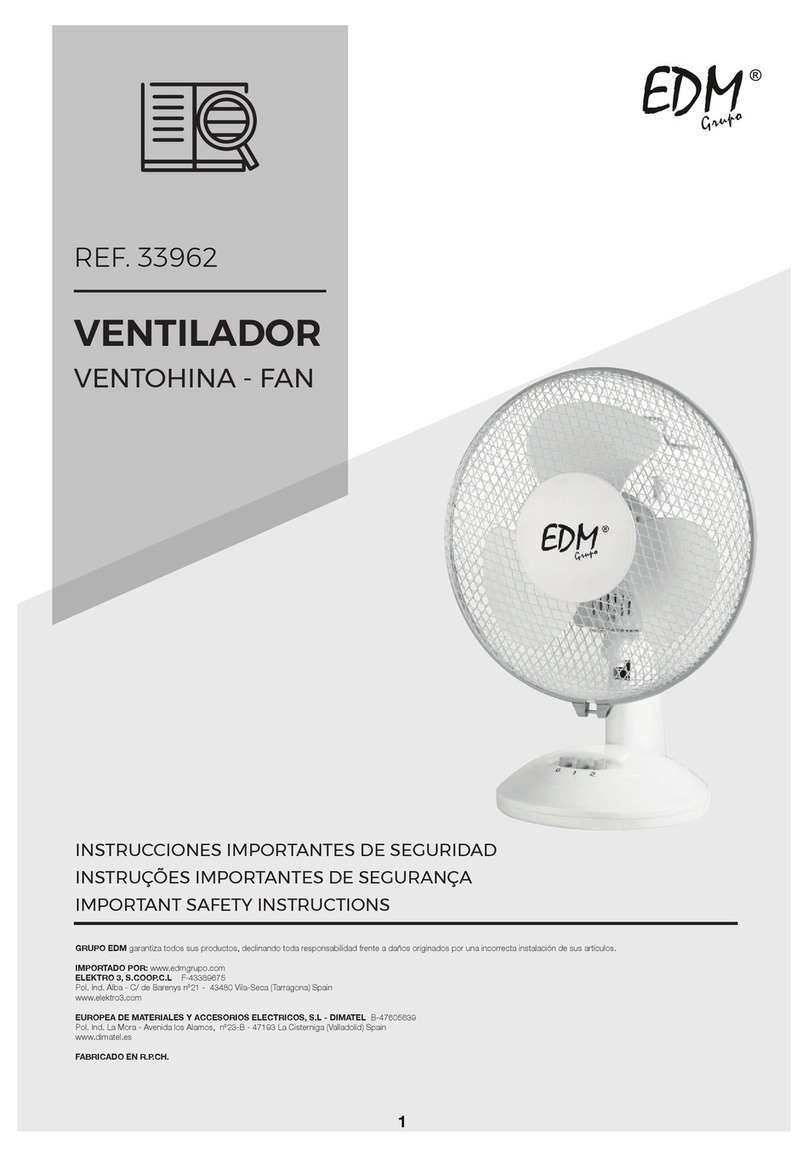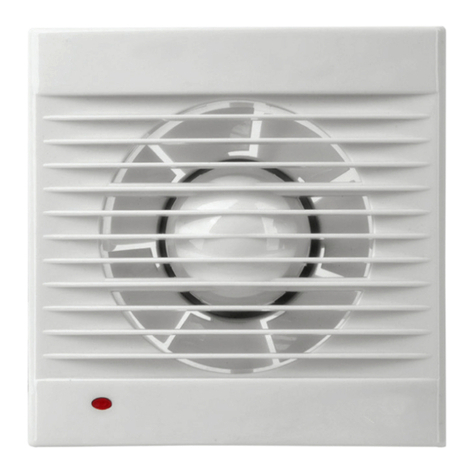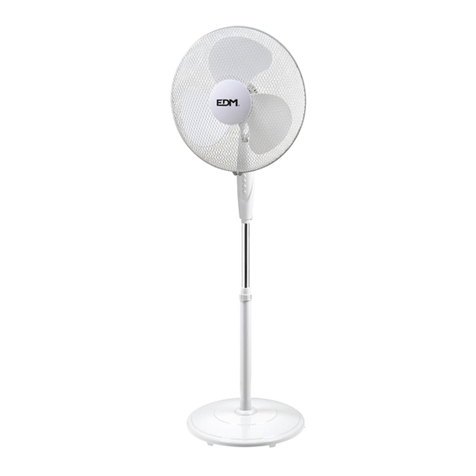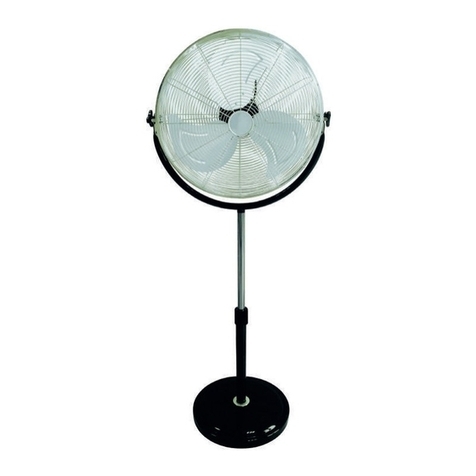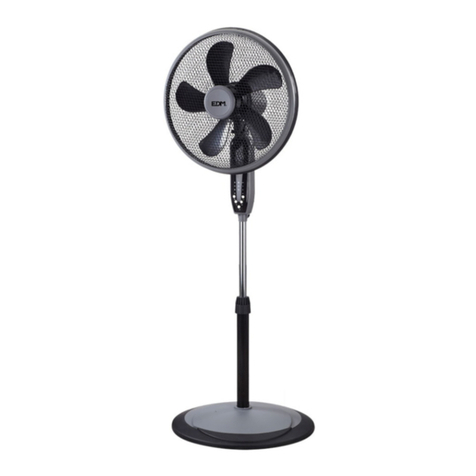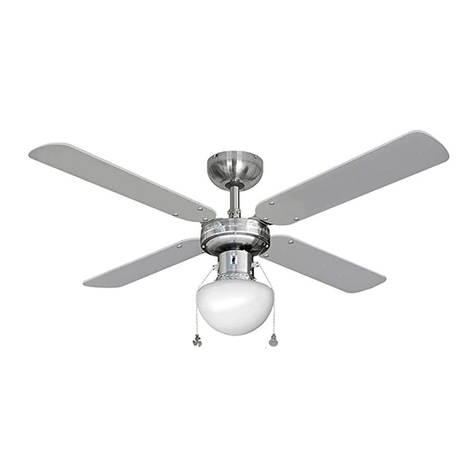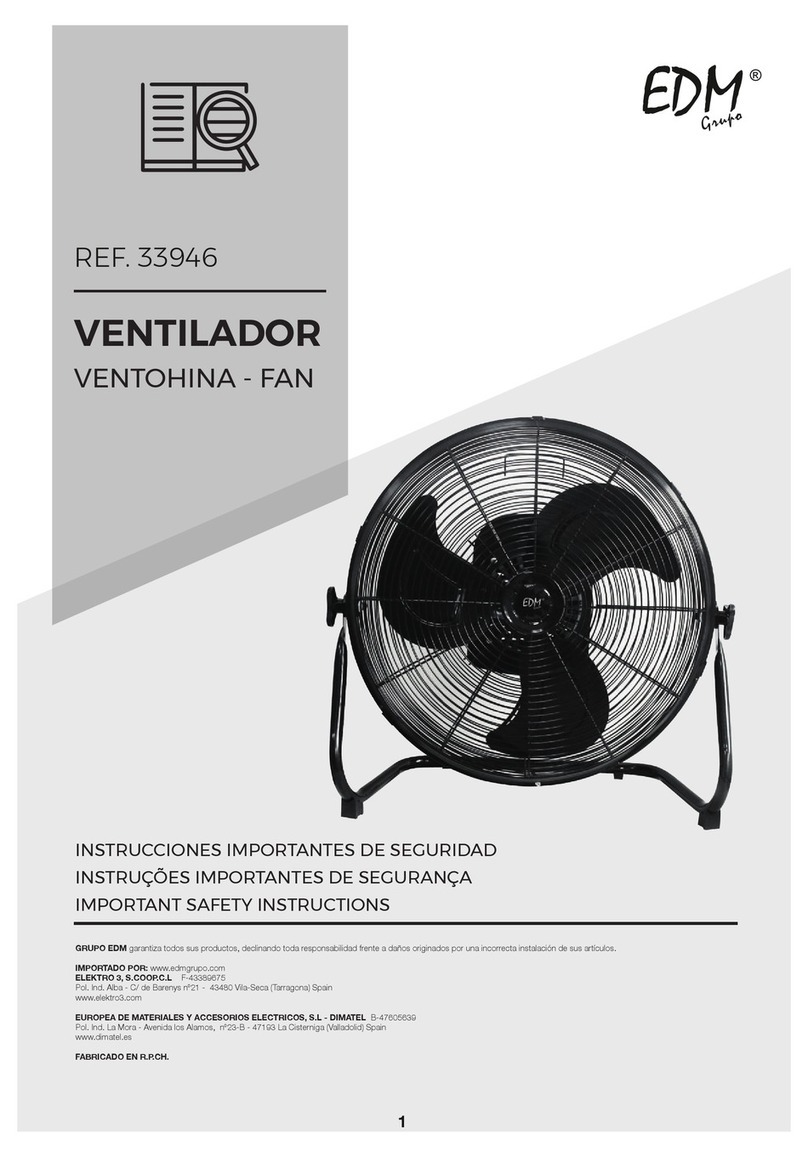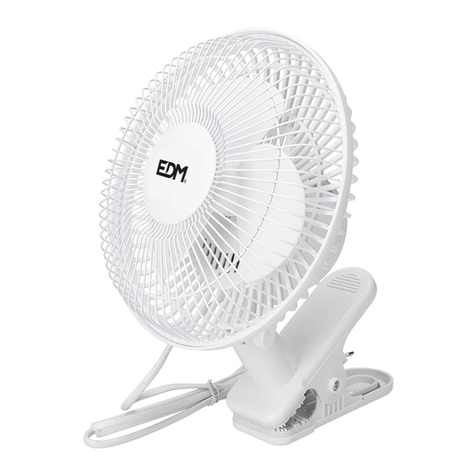
REF. 33805 INSTRUCCIONES IMPORTANTES DE SEGURIDAD
INSTRUÇÕES IMPORTANTES DE SEGURANÇA / IMPORTANT SAFETY INSTRUCTIONS
-7-
4
/ Do not use the lamp without the glass. If it is
damaged, it must be replaced with a new one
The lamp is designed to use only self-protected tungsten
halogen light bulbs.
Exclusive use in enclosed spaces.
IP Level of protection against intrusion. You can find the
corresponding protection level on the label of the lamp.
The luminaire can under no circumstances be mounted
on normally flammable surfaces.
Switching it on
Connect to the power supply and check the functioning of
the fan. A series of pulses controls the speed of the fan, as
follows:
Press once - fast; press 2 times - medium speed; press 3
times - slow; press 4 times - off. The speed adjustments to
increase or reduce the temperature will depend on factors
such as the size of the room, its height, the number of fans
available, etc. Using the sliding switch, you can control the
direction of the fan, forward or backward.
Hot temperatures/low position - (forward) The fan turns
anti-clockwise. The downward air current creates a cooling
effect, as shown in figure A.
This enables you to set the air conditioning to a higher
temperature without compromising on comfort.
Low temperatures/upper position - (backward) The fan turns
clockwise. The upward air current causes the warm air in the
upper part of the room to move to other areas, as shown in
figure B.
This enables you to set the heating to a lower temperature
without compromising on comfort.
(Before using your fan in this position, consult point 10 of
the safety instructions).
NOTE: Switch the fan off and wait until it has stopped
completely before changing the position of the sliding
switch forward or backward.
Maintenance
1. Due to the normal movement of the fan, it is possible that
some connections may come lose. Check the support
connections, the supports and the attachment of the blades
twice a year. Make sure they are securely attached.
4
/ Do not use the lamp without the glass. If it is
damaged, it must be replaced with a new one
The lamp is designed to use only self-protected tungsten
halogen light bulbs.
Exclusive use in enclosed spaces.
IP Level of protection against intrusion. You can find the
corresponding protection level on the label of the lamp.
The luminaire can under no circumstances be mounted
on normally flammable surfaces.
Switching it on
Connect to the power supply and check the functioning of
the fan. A series of pulses controls the speed of the fan, as
follows:
Press once - fast; press 2 times - medium speed; press 3
times - slow; press 4 times - off. The speed adjustments to
increase or reduce the temperature will depend on factors
such as the size of the room, its height, the number of fans
available, etc. Using the sliding switch, you can control the
direction of the fan, forward or backward.
Hot temperatures/low position - (forward) The fan turns
anti-clockwise. The downward air current creates a cooling
effect, as shown in figure A.
This enables you to set the air conditioning to a higher
temperature without compromising on comfort.
Low temperatures/upper position - (backward) The fan turns
clockwise. The upward air current causes the warm air in the
upper part of the room to move to other areas, as shown in
figure B.
This enables you to set the heating to a lower temperature
without compromising on comfort.
(Before using your fan in this position, consult point 10 of
the safety instructions).
NOTE: Switch the fan off and wait until it has stopped
completely before changing the position of the sliding
switch forward or backward.
Maintenance
1. Due to the normal movement of the fan, it is possible that
some connections may come lose. Check the support
connections, the supports and the attachment of the blades
twice a year. Make sure they are securely attached.
4
/ Do not use the lamp without the glass. If it is
damaged, it must be replaced with a new one
The lamp is designed to use only self-protected tungsten
halogen light bulbs.
Exclusive use in enclosed spaces.
IP Level of protection against intrusion. You can find the
corresponding protection level on the label of the lamp.
The luminaire can under no circumstances be mounted
on normally flammable surfaces.
Switching it on
Connect to the power supply and check the functioning of
the fan. A series of pulses controls the speed of the fan, as
follows:
Press once - fast; press 2 times - medium speed; press 3
times - slow; press 4 times - off. The speed adjustments to
increase or reduce the temperature will depend on factors
such as the size of the room, its height, the number of fans
available, etc. Using the sliding switch, you can control the
direction of the fan, forward or backward.
Hot temperatures/low position - (forward) The fan turns
anti-clockwise. The downward air current creates a cooling
effect, as shown in figure A.
This enables you to set the air conditioning to a higher
temperature without compromising on comfort.
Low temperatures/upper position - (backward) The fan turns
clockwise. The upward air current causes the warm air in the
upper part of the room to move to other areas, as shown in
figure B.
This enables you to set the heating to a lower temperature
without compromising on comfort.
(Before using your fan in this position, consult point 10 of
the safety instructions).
NOTE: Switch the fan off and wait until it has stopped
completely before changing the position of the sliding
switch forward or backward.
Maintenance
1. Due to the normal movement of the fan, it is possible that
some connections may come lose. Check the support
connections, the supports and the attachment of the blades
twice a year. Make sure they are securely attached.
tem-se-lhes dado a supervisão ou formação apropriadas com respeito ao uso do aparelho de uma
maneira segura e compreendem os perigos que implica. Os meninos não devem jogar com o
aparelho. A limpeza e a manutenção a realizar pelo utente não devem os realizar os meninos sem
supervisão.
21. Têm de ser incorporados na cablagem fixa os meios de desligar por completo a alimentação,
com uma separação do contacto em todos os pólos, de acordo com as regras da cablagem.
22. Relativamente às instruções do método de fixação e modo de instalação da ventoinha, consul-
te a secção "INSTALAÇÃO".
23. Relativamente ao método de ligação do fio, consulte a secção "INFORMAÇÃO DO FIO".
24. Relativamente às instruções de substituição da lâmpada incluídas no modelo ou referência do
tipo de dispositivo de iluminação, consulte a secção "Substituição da lâmpada".
DESCRIÇÃO DE SÍMBOLOS
Pode encontrar todos os símbolos relativos a esta ventoinha de teto tanto na etiqueta do produto
como na caixa da embalagem.
Classe de isolamento I Esta ventoinha deve ser ligada com a sua ligação de terra (cabo verde e
amarelo) ao condutor de terra.
Classe de isolamento II Esta ventoinha possui um isolamento duplo e não deve ser ligada à terra.
CA - Corrente Alternada (Alternating Current Voltage)
Frequência em hertz
Tensão em volts
Intensidade de corrente em watts
Distância mínima em metros entre o candeeiro e qualquer objeto inflamável. Pode encontrar
a distância exata na etiqueta do candeeiro.
Não utilize o candeeiro sem o vidro. Se este estiver danificado, deverá ser substituído por
outro novo.
O candeeiro foi concebido para ser usado unicamente com lâmpadas halógenas de
tungsténio autoprotegidas.
Uso exclusivo em espaços fechados.
Grau de proteção contra influências externas. Pode encontrar o grau de proteção
correspondente no rótulo docandeeiro.
A luminaria não deve se instalar baixo ningua circunstância sobre uma superfície
normalmente inflamável.
INSTRUÇÕES DE FUNCIONAMENTO
Ligue a ventoinha e comprove o seu funcionamento. A cadeia de impulsos controla a velocidade da
ventoinha da seguinte maneira:
1 impulso - rápida; 2 impulsos - velocidade média; 3 impulsos - lenta; 4 impulsos - apagada. A
regulação da velocidade para aumentar ou diminuir a temperatura dependem de fatores como o
tamanho e a altura do lugar de instalação, o número de ventoinhas disponíveis, etc.
Mediante o comutador deslizante pode controlar o sentido do fluxo de ar da ventoinha para baixo
ou para cima.
Temperaturas cálidas/posição baixa - (para a frente) A ventoinha gira no sentido contrário ao dos
ponteiros do relógio. O fluxo de ar orientado para baixo gera um efeito de refrigeração, como se
mostra na figura A. Isto permite colocar o seu ar condicionado a uma temperatura mais alta sem
ter de renunciar à sua comodidade.
Hz
V
W
3
15. This appliance can be used by children aged 8 years and
above and persons with reduced physical, sensory or mental
capabilities or lack of experience and knowladge if they have
been given supervision or instruction concerning use of the
appliance in a safe way and understand the hazards
involved. Children shall not play with the appliance.
Cleaning and user maintenance shall not be made by
children without supervisions.
16. The means for disconnection from the supply mains
having a contact separation in all poles that provides full
disconnection that must be incorporated in the fixed wiring
in accordance with the wiring rules.
17. Regarding the instructions for the method of fixing and
how to install the fan, thanks to refer to the section
“INSTALLATION”.
18. Regarding the method of the cable connection, thanks to
refer to the section "CABLE INFORMATION".
Description of symbols:
You will find all the symbols related to his lamp on both the
product label and the box in which it came.
Insulation class I . This fan must be connected with its
ground wire (green and yellow cable) to the earthing
conductor.
Insulation class II . This fan has double insulation and it
must not be connected to the earth connection.
AC - Alternating Current Voltage
Frequency (hertz)
Voltage in volts
Intensity of current in watts
Exclusive use in enclosed spaces.
IP Level of protection against intrusion. You can find the
corresponding protection level on the label of the lamp.
The luminaire can under no circumstances be mounted
on normally flammable surfaces.
Switching it on
Connect to the power supply and check the functioning of
the fan. A series of pulses controls the speed of the fan, as
follows:
Press once - fast; press 2 times - medium speed; press 3
times - slow; press 4 times - off. The speed adjustments to
increase or reduce the temperature will depend on factors
4
/ Do not use the lamp without the glass. If it is
damaged, it must be replaced with a new one
The lamp is designed to use only self-protected tungsten
halogen light bulbs.
Exclusive use in enclosed spaces.
IP Level of protection against intrusion. You can find the
corresponding protection level on the label of the lamp.
The luminaire can under no circumstances be mounted
on normally flammable surfaces.
Switching it on
Connect to the power supply and check the functioning of
the fan. A series of pulses controls the speed of the fan, as
follows:
Press once - fast; press 2 times - medium speed; press 3
times - slow; press 4 times - off. The speed adjustments to
increase or reduce the temperature will depend on factors
such as the size of the room, its height, the number of fans
available, etc. Using the sliding switch, you can control the
direction of the fan, forward or backward.
Hot temperatures/low position - (forward) The fan turns
anti-clockwise. The downward air current creates a cooling
effect, as shown in figure A.
This enables you to set the air conditioning to a higher
temperature without compromising on comfort.
Low temperatures/upper position - (backward) The fan turns
clockwise. The upward air current causes the warm air in the
upper part of the room to move to other areas, as shown in
figure B.
This enables you to set the heating to a lower temperature
without compromising on comfort.
(Before using your fan in this position, consult point 10 of
the safety instructions).
NOTE: Switch the fan off and wait until it has stopped
completely before changing the position of the sliding
switch forward or backward.
Maintenance
1. Due to the normal movement of the fan, it is possible that
some connections may come lose. Check the support
connections, the supports and the attachment of the blades
twice a year. Make sure they are securely attached.
4
/ Do not use the lamp without the glass. If it is
damaged, it must be replaced with a new one
The lamp is designed to use only self-protected tungsten
halogen light bulbs.
Exclusive use in enclosed spaces.
IP Level of protection against intrusion. You can find the
corresponding protection level on the label of the lamp.
The luminaire can under no circumstances be mounted
on normally flammable surfaces.
Switching it on
Connect to the power supply and check the functioning of
the fan. A series of pulses controls the speed of the fan, as
follows:
Press once - fast; press 2 times - medium speed; press 3
times - slow; press 4 times - off. The speed adjustments to
increase or reduce the temperature will depend on factors
such as the size of the room, its height, the number of fans
available, etc. Using the sliding switch, you can control the
direction of the fan, forward or backward.
Hot temperatures/low position - (forward) The fan turns
anti-clockwise. The downward air current creates a cooling
effect, as shown in figure A.
This enables you to set the air conditioning to a higher
temperature without compromising on comfort.
Low temperatures/upper position - (backward) The fan turns
clockwise. The upward air current causes the warm air in the
upper part of the room to move to other areas, as shown in
figure B.
This enables you to set the heating to a lower temperature
without compromising on comfort.
(Before using your fan in this position, consult point 10 of
the safety instructions).
NOTE: Switch the fan off and wait until it has stopped
completely before changing the position of the sliding
switch forward or backward.
Maintenance
1. Due to the normal movement of the fan, it is possible that
some connections may come lose. Check the support
connections, the supports and the attachment of the blades
twice a year. Make sure they are securely attached.
4
/ Do not use the lamp without the glass. If it is
damaged, it must be replaced with a new one
The lamp is designed to use only self-protected tungsten
halogen light bulbs.
Exclusive use in enclosed spaces.
IP Level of protection against intrusion. You can find the
corresponding protection level on the label of the lamp.
The luminaire can under no circumstances be mounted
on normally flammable surfaces.
Switching it on
Connect to the power supply and check the functioning of
the fan. A series of pulses controls the speed of the fan, as
follows:
Press once - fast; press 2 times - medium speed; press 3
times - slow; press 4 times - off. The speed adjustments to
increase or reduce the temperature will depend on factors
such as the size of the room, its height, the number of fans
available, etc. Using the sliding switch, you can control the
direction of the fan, forward or backward.
Hot temperatures/low position - (forward) The fan turns
anti-clockwise. The downward air current creates a cooling
effect, as shown in figure A.
This enables you to set the air conditioning to a higher
temperature without compromising on comfort.
Low temperatures/upper position - (backward) The fan turns
clockwise. The upward air current causes the warm air in the
upper part of the room to move to other areas, as shown in
figure B.
This enables you to set the heating to a lower temperature
without compromising on comfort.
(Before using your fan in this position, consult point 10 of
the safety instructions).
NOTE: Switch the fan off and wait until it has stopped
completely before changing the position of the sliding
switch forward or backward.
Maintenance
1. Due to the normal movement of the fan, it is possible that
some connections may come lose. Check the support
connections, the supports and the attachment of the blades
twice a year. Make sure they are securely attached.
0,5m
IP






